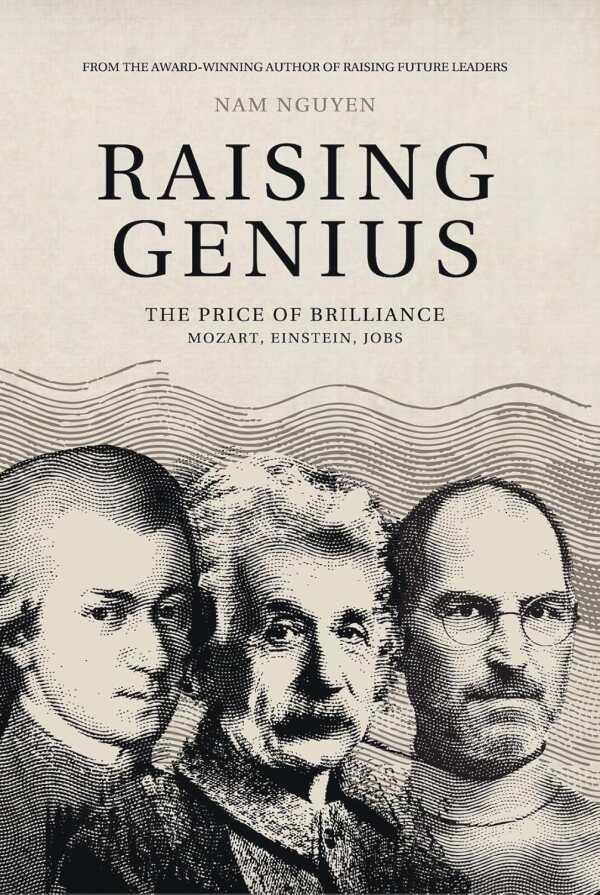
Raising Genius
Mozart, Einstein, Jobs
Detailed and expressive, the biographical novellas of Raising Genius muse through parental influences on creative minds.
Dramatizing the early childhoods and complicated family lives of three world-renowned visionaries, Nam Nguyen’s Raising Genius is an ambitious fictionalized account of the long shadows that parental influences cast over the careers of Wolfgang Amadeus Mozart, Albert Einstein, and Steve Jobs.
Across three self-contained narratives, Raising Genius explores different ways in which “genius” can be the product of the control and influence of one’s early-childhood authority figures. Each narrative is written in an earthy, florid tone that takes creative liberties with its respective central figure, though remaining grounded in the minutiae of the historical record.
As period pieces, the book’s three sections show a remarkable fidelity to their chosen eras, fleshing out the neoclassical parlors and palaces of central Europe in the Mozart narrative, the universities and cafés of prewar Berlin in the Einstein sequence, and the garages and tech-wiz conventions of the early California technology startup scene in the Jobs section. Indeed, the detail-rich narrative style lends an impressive degree of color and liveliness to each of the book’s subjects, though juggling the burgeoning cast of supporting characters and settings proves more complicated.
While sharing a general overall structure, the individual sections are uneven in their scope. The Jobs narrative is at once the briefest, tightest, and most balanced of the three, sketching multiple threads of dramatic tension while remaining focused on its emotional core: Jobs’s powerful and self-destructive creative ambition. The Einstein sequence includes the most dynamic parental figure of the book in Pauline Einstein, Albert’s stern but affectionate gadfly of a mother. However, this character portrait is weakened by the repetitiveness of Pauline’s constant streams of advice, always a one-two punch of praise coupled with a practical reminder.
The Mozart narrative is the longest and most detailed, but its length causes it to flounder within repetitive set pieces and conversations. Some characters within it, including Mozart’s mother, Anna Maria, are quite static, their behavior predictable in spite of their otherwise rich interiority. In scene after scene, Leopold Mozart insists upon rigid discipline for his children, and Anna Maria cautions him about the toll this takes on her son; the dynamic remains unchanged, though.
In the same way, near-identical scenes show young Mozart winning over skeptical crowds of potential patrons in near-identical ways, with near-identical consequences. Not until the section’s closing sequence, set in a Naples opera house, is true drama attained: Wolfgang, at last, matures, even as those around him remain locked in old routines.
The book’s extensive use of similes has a textured, atmospheric effect, used to flesh out characters’ interior lives in the early chapters of each section. But with their sheer density, especially in the Mozart sequence, these flourishes become distracting. In its heavy use of such tropes, the book leans too much on what are otherwise its greatest strengths: its rich figurative language and its often sagacious character exchanges.
The biographical novellas collected in Raising Genius flesh out three world-shaping intellects in detail, focusing on the mixed impacts of their parental figures on their development.
Reviewed by
Isaac Randel
Disclosure: This article is not an endorsement, but a review. The publisher of this book provided free copies of the book and paid a small fee to have their book reviewed by a professional reviewer. Foreword Reviews and Clarion Reviews make no guarantee that the publisher will receive a positive review. Foreword Magazine, Inc. is disclosing this in accordance with the Federal Trade Commission’s 16 CFR, Part 255.
